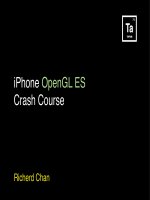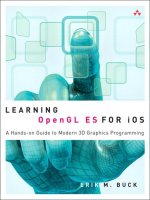Pro OpenGL ES for Android potx
Bạn đang xem bản rút gọn của tài liệu. Xem và tải ngay bản đầy đủ của tài liệu tại đây (6.58 MB, 309 trang )
www.it-ebooks.info
For your convenience Apress has placed some of the front
matter material after the index. Please use the Bookmarks
and Contents at a Glance links to access them.
www.it-ebooks.info
iv
Contents at a Glance
■About the Authors x
■About the Technical Reviewer xi
■Acknowledgments xii
■Introduction xiii
■Chapter 1: Computer Graphics: From Then to Now 1
■Chapter 2: All That Math Jazz 25
■Chapter 3: From 2D to 3D: Adding One Extra Dimension 43
■Chapter 4: Turning on the Lights 77
■Chapter 5: Textures 115
■Chapter 6: Will It Blend? 149
■Chapter 7: Well-Rendered Miscellany 177
■Chapter 8: Putting It All Together 213
■Chapter 9: Performance ’n’ Stuff 247
■Chapter 10: OpenGL ES 2, Shaders, and… 259
■Index 287
www.it-ebooks.info
xiii
Introduction
In 1985 I brought home a new shiny Commodore Amiga 1000, about one week after
they were released. Coming with a whopping 512K of memory, programmable
colormaps, a Motorola 68K CPU, and a modern multitasking operating system, it had
“awesome” writ all over it. Metaphorically speaking, of course. I thought it might
make a good platform for an astronomy program, as I could now control the colors of
those star-things instead of having to settle for a lame fixed color palette forced upon
me from the likes of Hercules or the C64. So I coded up a 24-line basic routine to
draw a random star field, turned out the lights, and thought, “Wow! I bet I could write
a cool astronomy program for that thing!” Twenty-six years later I am still working on
it and hope to get it right one of these days. Back then my dream device was
something I could slip into my pocket, pull out when needed, and aim it at the sky to
tell me what stars or constellations I was looking at.
It’s called a smartphone.
I thought of it first.
As good as these things are for playing music, making calls, or slinging birdies at
piggies, it really shines when you get to the 3D stuff. After all, 3D is all around us—
unless you are a pirate and have taken to wearing an eye patch, in which case you’ll
have very limited depth perception. Arrrggghhh.
Plus 3D apps are fun to show off to people. They’ll “get it.” In fact, they’ll get it much
more than, say, that mulch buyer’s guide app all the kids are talking about. (Unless
they show off their mulch in 3D, but that would be a waste of a perfectly good
dimension.)
So, 3D apps are fun to see, fun to interact with, and fun to program. Which brings me
to this book. I am by no means a guru in this field. The real gurus are the ones who
can knock out a couple of NVIDIA drivers before breakfast, 4-dimensional hypercube
simulators by lunch, and port Halo to a TokyoFlash watch before the evening’s Firefly
marathon on SyFy. I can’t do that. But I am a decent writer, have enough of a working
knowledge of the subject to make me harmless, and know how to spell “3D.” So here
we are.
www.it-ebooks.info
■ Introduction
xiv
First and foremost this book is for experienced Android programmers who want to at
least learn a little of the language of 3D. At least enough to where at the next game
programmer’s cocktail party you too can laugh at the quaternion jokes with the best
of them.
This book covers the basics in both theory of 3D and implementations using the
industry standard OpenGL ES toolkit for small devices. While Android can support
both flavors—version 1.x for the easy way, and version 2.x for those who like to get
where the nitty-is-gritty—I mainly cover the former, except in the final chapter which
serves as an intro to the latter and the use of programmable shaders.
Chapter 1 serves as an intro to OpenGL ES alongside the long and tortuous path of the
history of computer graphics. Chapter 2 is the math behind basic 3D rendering,
whereas Chapters 3 through 8 lead you gently through the various issues all graphics
programmers eventually come across, such as how to cast shadows, render multiple
OpenGL screens, add lens flare, and so on. Eventually this works its way into a simple
(S-I-M-P-L-E!) solar-system model consisting of the sun, earth, and some stars—a
traditional 3D exercise. Chapter 9 looks at best practices and development tools, and
Chapter 10 serves as a brief overview of OpenGL ES 2 and the use of shaders.
So, have fun, send me some M&Ms, and while you’re at it feel free to check out my
own app currently just in the Apple App Store: Distant Suns 3. Yup, that’s the same
application that started out on a Commodore Amiga 1000 in 1985 as a 24-line basic
program that drew a couple hundred random stars on the screen.
It’s bigger now.
–Mike Smithwick
www.it-ebooks.info
1
Chapter
Computer Graphics: From
Then to Now
To predict the future and appreciate the present, you must understand the past.
—Probably said by someone sometime
Computer graphics have always been the darling of the software world. Laypeople can appreciate
computer graphics more easily than, say, increasing the speed of a sort algorithm by 3 percent or
adding automatic tint control to a spreadsheet program. You are likely to hear more people say
“Coooool!” at your nicely rendered image of Saturn on your iPad than at a Visual Basic script in
Microsoft Word (unless, of course, a Visual Basic script in Microsoft Word can render Saturn; then that
really would be cool). The cool factor goes up even more when said renderings are on a device you
can carry around in your back pocket. Let’s face it—the folks in Silicon Valley are making the life of art
directors on science-fiction films very difficult. After all, imagine how hard it must be to design a prop
that looks more futuristic than a Samsung Galaxy Tab or an iPad. (Even before Apple’s iPhone was
available for sale, the prop department at ABC’s Lost borrowed some of Apple’s screen iconography for
use in a two-way radio carried by a mysterious helicopter pilot.)
If you are reading this book, chances are you have an Android-based device or are considering getting
one in the near future. If you have one, put it in your hand now and consider what a miracle it is of
21st-century engineering. Millions of work hours, billions of dollars of research, centuries of overtime,
plenty of all-nighters, and an abundance of Jolt-drinking, T-shirt–wearing, comic-book-loving
engineers coding into the silence of the night have gone into making that little glass and plastic
miracle-box so you can play Angry Birds when Mythbusters is in reruns.
1
www.it-ebooks.info
CHAPTER 1: Computer Graphics: From Then to Now
2
Your First OpenGL ES Program
Some software how-to books will carefully build up the case for their specific topic (“the boring stuff”)
only to get to the coding and examples (“the fun stuff”) by around page 655. Others will jump
immediately into some exercises to address your curiosity and save the boring stuff for a little later.
This book will attempt to be of the latter category.
NOTE: OpenGL ES is a 3D graphics standard based on the OpenGL library that emerged from the
labs of Silicon Graphics in 1992. It is widely used across the industry in everything from
pocketable machines running games up to supercomputers running fluid dynamics simulations
for NASA (and playing really, really fast games). The ES variety stands for
Embedded
Systems
,
meaning small, portable, low-power devices.
When installed, the Android SDK comes with many very good and concise examples ranging from Near
Field Communications (NFC) to UI to OpenGL ES projects. Our earliest examples will leverage those
that you will find in the wide-ranging ApiDemos code base. Unlike its Apple-lovin’ cousin Xcode, which
has a nice selection of project wizards that includes an OpenGL project, the Android dev system
unfortunately has very few. As a result, we have to start at a little bit of a disadvantage as compared to
the folks in Cupertino. So, you’ll need to create a generic Android project, which I am sure you already
know how to do. When done, add a new class named Square.java, consisting of the code in Listing
1–1. A detailed analysis follows the listing.
Listing 1–1.
A 2D Square Using OpenGL ES
package book.BouncySquare;
import java.nio.ByteBuffer;
import java.nio.ByteOrder;
import java.nio.FloatBuffer;
import java.nio.IntBuffer;
import javax.microedition.khronos.opengles.GL10; //1
import javax.microedition.khronos.opengles.GL11;
/**
* A vertex shaded square.
*/
class Square
{
public Square()
{
float vertices[] = //2
www.it-ebooks.info
CHAPTER 1: Computer Graphics: From Then to Now
3
{
-1.0f, -1.0f,
1.0f, -1.0f,
-1.0f, 1.0f,
1.0f, 1.0f
};
byte maxColor=(byte)255;
byte colors[] = //3
{
maxColor,maxColor, 0,maxColor,
0, maxColor,maxColor,maxColor,
0, 0, 0,maxColor,
maxColor, 0,maxColor,maxColor
};
byte indices[] = //4
{
0, 3, 1,
0, 2, 3
};
ByteBuffer vbb = ByteBuffer.allocateDirect(vertices.length * 4); //5
vbb.order(ByteOrder.nativeOrder());
mFVertexBuffer = vbb.asFloatBuffer();
mFVertexBuffer.put(vertices);
mFVertexBuffer.position(0);
mColorBuffer = ByteBuffer.allocateDirect(colors.length);
mColorBuffer.put(colors);
mColorBuffer.position(0);
mIndexBuffer = ByteBuffer.allocateDirect(indices.length);
mIndexBuffer.put(indices);
mIndexBuffer.position(0);
}
public void draw(GL10 gl) //6
{
gl.glFrontFace(GL11.GL_CW); //7
gl.glVertexPointer(2, GL11.GL_FLOAT, 0, mFVertexBuffer); //8
gl.glColorPointer(4, GL11.GL_UNSIGNED_BYTE, 0, mColorBuffer); //9
gl.glDrawElements(GL11.GL_TRIANGLES, 6, //10
GL11.GL_UNSIGNED_BYTE, mIndexBuffer);
gl.glFrontFace(GL11.GL_CCW); //11
}
www.it-ebooks.info
CHAPTER 1: Computer Graphics: From Then to Now
4
private FloatBuffer mFVertexBuffer;
private ByteBuffer mColorBuffer;
private ByteBuffer mIndexBuffer;
}
Before I go on to the next phase, I’ll break down the code from Listing 1–1 that constructs a
polychromatic square:
Java hosts several different OpenGL interfaces. The parent class is merely called
GL, while OpenGL ES 1.0 uses GL10, and version 1.1 is imported as GL11, shown
in line 1. You can also gain access to some extensions if your graphics hardware
supports them via the GL10Ext package, supplied by the GL11ExtensionPack.
The later versions are merely subclasses of the earlier ones; however, there are
still some calls that are defined as taking only GL10 objects, but those work if you
cast the objects properly.
In line 2 we define our square. You will rarely if ever do it this way because many
objects could have thousands of vertices. In those cases, you’d likely import them
from any number of 3D file formats such as Imagination Technologies’ POD files,
3D Studio’s .3ds files, and so on. Here, since we’re describing a 2D square, it is
necessary to specify only x and y coordinates. And as you can see, the square is
two units on a side.
Colors are defined similarly, but in this case, in lines 3ff, there are four
components for each color: red, green, blue, and alpha (transparency). These map
directly to the four vertices shown earlier, so the first color goes with the first
vertex, and so on. You can use floats or a fixed or byte representation of the
colors, with the latter saving a lot of memory if you are importing a very large
model. Since we’re using bytes, the color values go from 0 to 255, That means the
first color sets red to 255, green to 255, and blue to 0. That will make a lovely,
while otherwise blinding, shade of yellow. If you use floats or fixed point, they
ultimately are converted to byte values internally. Unlike its big desktop brother,
which can render four-sided objects, OpenGL ES is limited to triangles only. In
lines 4ff the connectivity array is created. This matches up the vertices to specific
triangles. The first triplet says that vertices 0, 3, and 1 make up triangle 0, while
the second triangle is comprised of vertices 0, 2, and 3.
Once the colors, vertices, and connectivity array have been created, we may have
to fiddle with the values in a way to convert their internal Java formats to those
that OpenGL can understand, as shown in lines 5ff. This mainly ensures that the
ordering of the bytes is right; otherwise, depending on the hardware, they might
be in reverse order.
www.it-ebooks.info
CHAPTER 1: Computer Graphics: From Then to Now
5
The draw method, in line 6, is called by SquareRenderer.drawFrame(),
covered shortly.
Line 7 tells OpenGL how the vertices are ordering their faces. Vertex ordering can be
critical when it comes to getting the best performance out of your software. It helps to
have the ordering uniform across your model, which can indicate whether the triangles
are facing toward or away from your viewpoint. The latter ones are called backfacing
triangles the back side of your objects, so they can be ignored, cutting rendering time
substantially. So, by specifying that the front face of the triangles are GL_CW, or
clockwise, all counterclockwise triangles are culled. Notice that in line 11 they are
reset to GL_CCW, which is the default.
In lines 8, 9, and 10, pointers to the data buffers are handed over to the renderer. The
call to glVertexPointer() specifies the number of elements per vertex (in this case
two), that the data is floating point, and that the “stride” is 0 bytes. The data can be
eight different formats, including floats, fixed, ints, short ints, and bytes. The latter
three are available in both signed and unsigned flavors. Stride is a handy way to let
you interleave OpenGL data with your own as long as the data structures are constant.
Stride is merely the number of bytes of user info packed between the GL data so the
system can skip over it to the next bit it will understand.
In line 9, the color buffer is sent across with a size of four elements, with the RGBA
quadruplets using unsigned bytes (I know, Java doesn’t have unsigned anything, but
GL doesn’t have to know), and it too has a stride=0.
And finally, the actual draw command is given, which requires the connectivity array.
The first parameter says what the format the geometry is in, in other words, triangles,
triangle lists, points, or lines.
Line 11 has us being a good neighbor and resetting the front face ordering back to
GL_CCW in case the previous objects used the default value.
Now our square needs a driver and way to display its colorful self on the screen. Create another file
called SquareRenderer.java, and populate it with the code in Listing 1–2.
Listing 1–2.
The Driver for Our First OpenGL Project
package book.BouncySquare;
import javax.microedition.khronos.egl.EGL10; //1
import javax.microedition.khronos.egl.EGLConfig;
import javax.microedition.khronos.opengles.GL10;
import android.opengl.GLSurfaceView; //2
import java.lang.Math;
www.it-ebooks.info
CHAPTER 1: Computer Graphics: From Then to Now
6
class SquareRenderer implements GLSurfaceView.Renderer
{
public SquareRenderer(boolean useTranslucentBackground)
{
mTranslucentBackground = useTranslucentBackground;
mSquare = new Square(); //3
}
public void onDrawFrame(GL10 gl) //4
{
gl.glClear(GL10.GL_COLOR_BUFFER_BIT | GL10.GL_DEPTH_BUFFER_BIT); //5
gl.glMatrixMode(GL10.GL_MODELVIEW); //6
gl.glLoadIdentity(); //7
gl.glTranslatef(0.0f,(float)Math.sin(mTransY), -3.0f); //8
gl.glEnableClientState(GL10.GL_VERTEX_ARRAY); //9
gl.glEnableClientState(GL10.GL_COLOR_ARRAY);
mSquare.draw(gl); //10
mTransY += .075f;
}
public void onSurfaceChanged(GL10 gl, int width, int height) //11
{
gl.glViewport(0, 0, width, height); //12
float ratio = (float) width / height;
gl.glMatrixMode(GL10.GL_PROJECTION); //13
gl.glLoadIdentity();
gl.glFrustumf(-ratio, ratio, -1, 1, 1, 10); //14
}
public void onSurfaceCreated(GL10 gl, EGLConfig config) //15
{
gl.glDisable(GL10.GL_DITHER); //16
gl.glHint(GL10.GL_PERSPECTIVE_CORRECTION_HINT, //17
GL10.GL_FASTEST);
if (mTranslucentBackground) //18
{
gl.glClearColor(0,0,0,0);
}
else
{
www.it-ebooks.info
CHAPTER 1: Computer Graphics: From Then to Now
7
gl.glClearColor(1,1,1,1);
}
gl.glEnable(GL10.GL_CULL_FACE); //19
gl.glShadeModel(GL10.GL_SMOOTH); //20
gl.glEnable(GL10.GL_DEPTH_TEST); //21
}
private boolean mTranslucentBackground;
private Square mSquare;
private float mTransY;
private float mAngle;
}
A lot of things are going on here:
The EGL libraries in line 1 bind the OpenGL drawing surface to the system but are
buried within GLSurfaceview in this case, as shown in line 2. EGL is primarily
used for allocating and managing the drawing surfaces and is part of an OpenGL
ES extension, so it is platform independent.
In line 3, the square object is allocated and cached.
onDrawFrame() in line 4 is the root refresh method; this constructs the image
each time through, many times a second. And the first call is typically to clear the
entire screen, as shown in line 5. Considering that a frame can be constructed out
of several components, you are given the option to select which of those should
be cleared every frame. The color buffer holds all of the RGBA color data, while
the depth buffer is used to ensure that the closer items properly obscure the
further items.
Lines 6 and 7 start mucking around with the actual 3D parameters; these details
will be covered later. All that is being done here is setting the values to ensure
that the example geometry is immediately visible.
Next, line 8 translates the box up and down. To get a nice, smooth motion, the
actual translation value is based on a sine wave. The value mTransY is simply
used to generate a final up and down value that ranges from -1 to +1. Each time
through drawFrame(), the translation is increased by .075. Since we’re taking
the sine of this, it isn’t necessary to loop the value back on itself, because sine
will do that for us. Try increasing the value of mTransY to .3 and see what
happens.
Lines 9f tells OpenGL to expect both vertex and color data.
Finally, after all of this setup code, we can call the actual drawing routine of the
mSquare that you’ve seen before, as shown in line 10.
www.it-ebooks.info
CHAPTER 1: Computer Graphics: From Then to Now
8
onSurfaceChanged(), here in line 11, is called whenever the screen changes
size or is created at startup. Here it is also being used to set up the viewing
frustum, which is the volume of space that defines what you can actually see. If
any of your scene elements lay outside of the frustum, they are considered
invisible so are clipped, or culled out, to prevent that further operations are done
on them.
glViewport merely permits you to specify the actual dimensions and placement
of your OpenGL window. This will typically be the size of your main screen, with a
location 0.
In line 13, we set the matrix mode. What this does is to set the current working
matrix that will be acted upon when you make any general-purpose matrix
management calls. In this case, we switch to the GL_PROJECTION matrix, which
is the one that projects the 3D scene to your 2D screen. glLoadIdentity()
resets the matrix to its initial values to erase any previous settings.
Now you can set the actual frustum using the aspect ratio and the six clipping
planes: near/far, left/right, and top/bottom.
In this final method of Listing 1–2, some initialization is done upon surface
creation line 15. Line 16 ensures that any dithering is turned off, because it
defaults to on. Dithering in OpenGL makes screens with limited color palettes look
somewhat nicer but at the expense of performance of course.
glHint() in line 17 is used to nudge OpenGL ES to do what it thinks best by
accepting certain trade-offs: usually speed vs. quality. Other hintable settings
include fog and various smoothing options.
Another one of the many states we can set is the color that the background
assumes when cleared. In this case, which is black, if the background is
translucent, or white, (all colors max out to 1), if not translucent. Go ahead and
change these later to see what happens.
At last, the end of this listing sets some other handy modes. Line 19 says to cull
out faces (triangles) that are aimed away from us. Line 20 tells it to use smooth
shading so the colors blend across the surface. The only other value is GL_FLAT,
which, when activated, will display the face in the color of the last vertex drawn.
And line 21 enables depth testing, also known as z-buffering, covered later.
Finally, the activity file will need to be modified to look like Listing 1–3.
Listing 1–3.
The Activity File
package book.BouncySquare;
www.it-ebooks.info
CHAPTER 1: Computer Graphics: From Then to Now
9
import android.app.Activity;
import android.opengl.GLSurfaceView;
import android.os.Bundle;
import android.view.WindowManager;
import book.BouncySquare.*;
public class BouncySquareActivity extends Activity
{
/** Called when the activity is first created. */
@Override
public void onCreate(Bundle savedInstanceState)
{
super.onCreate(savedInstanceState);
getWindow().setFlags(WindowManager.LayoutParams.FLAG_FULLSCREEN,
WindowManager.LayoutParams.FLAG_FULLSCREEN);
GLSurfaceView view = new GLSurfaceView(this);
view.setRenderer(new SquareRenderer(true));
setContentView(view);
}
}
Our activity file is little modified from the default. Here the GLSurfaceView is actually allocated and
bound to our custom renderer, SquareRenderer.
Now compile and run. You should see something that looks a little like Figure 1–1.
Figure 1–1.
A bouncy square. If this is what you see, give yourself a high-five.
www.it-ebooks.info
CHAPTER 1: Computer Graphics: From Then to Now
1
0
Now as engineers, we all like to twiddle and tweak our creations, just to see what happens. So, let’s
change the shape of the bouncing-square-of-joy by replacing the first number in the vertices array
with -2.0, instead of -1.0. And replace maxcolor, the first value in the color array with a 0. That will
make the lower-left vertex stick out quite a ways and should turn it to green. Compile and stand back
in awe. You should have something like Figure 1–2.
Figure 1–2.
After the tweakage
Don’t worry about the simplicity of this first exercise; you’ll build stuff fancier than a bouncing
rainbow-hued cube of Jell-O at some point. The main project will be to construct a simple solar-
system simulator based on some of the code used in Distant Suns 3. But for now, it’s time to get to the
boring stuff: where computer graphics came from and where they are likely to go.
NOTE: The Android emulator is notoriously buggy and notoriously slow. It is strongly
recommended that you do all of your OpenGL work on real hardware, especially as the exercises
get a little more complex. You will save yourself a lot of grief.
www.it-ebooks.info
CHAPTER 1: Computer Graphics: From Then to Now
11
A Spotty History of Computer Graphics
To say that 3D is all the rage today is at best an understatement. Although forms of “3D” imagery go
back to more than a century ago, it seems that it has finally come of age. First let’s look at what 3D is
and what it is not.
3D in Hollywood
In 1982 Disney released Tron, the first movie to widely use computer graphics depicting life inside a
video game. Although the movie was a critical and financial flop, it would eventually join the ranks of
cult favorites right up there with The Rocky Horror Picture Show. Hollywood had taken the bite out of
the apple, and there was no turning back.
Stretching back to the 1800s, what we call “3D” today was more commonly referred to as stereo
vision. Popular Victorian-era stereopticons would be found in many parlors of the day. Consider this
technology an early Viewmaster. The user would hold the stereopticon up to their face with a stereo
photograph slipped into the far end and see a view of some distant land, but in stereo rather than a flat
2D picture. Each eye would see only one half of the card, which carried two nearly identical photos
taken only a couple of inches apart.
Stereovision is what gives us the notion of a depth component to our field of view. Our two eyes
deliver two slightly different images to the brain that then interprets them in a way that we understand
as depth perception. A single image will not have that effect. Eventually this moved to movies, with a
brief and unsuccessful dalliance as far back as 1903 (the short L’arrivée du Train is said to have had
viewers running from the theater to avoid the train that was clearly heading their way) and a
resurgence in the early 1950s, with Bwana Devil being perhaps the best known.
The original form of 3D movies generally used the “anaglyph” technique that required the viewers to
wear cheap plastic glasses with a red filter over one eye and a blue one over the other. Polarizing
systems were incorporated in the early 1950s and permitted color movies to be seen in stereo, and
they are still very much the same as today. Afraid that television would kill off the movie industry,
Hollywood needed some gimmick that was impossible on television in order to keep selling tickets, but
because both the cameras and the projectors required were much too impractical and costly, the form
fell out of favor, and the movie industry struggled along just fine.
With the advent of digital projection systems in the 1990s and fully rendered films such as Toy Story,
stereo movies and eventually television finally became both practical and affordable enough to move it
beyond the gimmick stage. In particular, full-length 3D animated features (Toy Story being the first)
made it a no-brainer to convert to stereo. All one needed to do was simply rerender the entire film but
from a slightly different viewpoint. This is where stereo and 3D computer graphics merge.
www.it-ebooks.info
CHAPTER 1: Computer Graphics: From Then to Now
12
The Dawn of Computer Graphics
One of the fascinating things about the history of computer graphics, and computers in general, is that
the technology is still so new that many of the giants still stride among us. It would be tough to track
down whoever invented the buggy whip, but I know who to call if you wanted to hear firsthand how
the Apollo Lunar Module computers were programmed in the 1960s.
Computer graphics (frequently referred to as CG) come in three overall flavors: 2D for user interface,
3D in real time for flight or other forms of simulation as well as games, and 3D rendering where quality
trumps speed for non-real-time use.
MIT
In 1961, an MIT engineering student named Ivan Sutherland created a system called Sketchpad for his
PhD thesis using a vectorscope, a crude light pen, and a custom-made Lincoln TX-2 computer (a spin-
off from the TX-2 group would become DEC). Sketchpad’s revolutionary graphical user interface
demonstrated many of the core principles of modern UI design, not to mention a big helping of object-
oriented architecture tossed in for good measure.
NOTE: For a video of Sketchpad in operation, go to YouTube and search for
Sketchpad
or
Ivan
Sutherland
.
A fellow student of Sutherland’s, Steve Russell, would invent perhaps one of the biggest time sinks
ever made, the computer game. Russell created the legendary game of Spacewar in 1962, which ran
on the PDP-1, as shown in Figure 1–3.
www.it-ebooks.info
CHAPTER 1: Computer Graphics: From Then to Now
13
Figure 1–3.
The 1962 game of Spacewar resurrected at the Computer History Museum in Mountain View,
California, on a vintage PDP-1. Photo by Joi Itoh, licensed under the Creative Commons Attribution 2.0 Generic
license (
/>).
By 1965, IBM would release what is considered the first widely used commercial graphics terminal,
the 2250. Paired with either the low-cost IBM-1130 computer or the IBM S/340, the terminal was
meant largely for use in the scientific community.
Perhaps one of the earliest known examples of computer graphics on television was the use of a 2250
on the CBS news coverage of the joint Gemini 6 and Gemini 7 mannded space missions in December
1965 (IBM built the Gemini’s onboard computer system). The terminal was used to demonstrate
several phases of the mission on live television from liftoff to rendezvous. At a cost of about $100,000
in 1965, it was worth the equivalent of a nice home. See Figure 1–4.
Figure 1–4
. IBM-2250 terminal from 1965. Courtesy NASA.
www.it-ebooks.info
CHAPTER 1: Computer Graphics: From Then to Now
14
University of Utah
Recruited by the University of Utah in 1968 to work in its computer science program, Sutherland
naturally concentrated on graphics. Over the course of the next few years, many computer graphics
visionaries in training would pass through the university’s labs.
Ed Catmull, for example, loved classic animation but was frustrated by his inability to draw—a
requirement for artists back in those days as it would appear. Sensing that computers might be a
pathway to making movies, Catmull produced the first-ever computer animation, which was of his
hand opening and closing. This clip would find its way into the 1976 film Future World.
During that time he would pioneer two major computer graphics innovations: texture mapping and
bicubic surfaces. The former could be used to add complexity to simple forms by using images of
texture instead of having to create texture and roughness using discrete points and surfaces, as
shown in Figure 1–5. The latter is used to generate algorithmically curved surfaces that are much
more efficient than the traditional polygon meshes.
Figure 1–5.
Saturn with and without texture
Catmull would eventually find his way to Lucasfilm and, later, Pixar and eventually serve as president
of Disney Animation Studios where he could finally make the movies he wanted to see. Not a bad gig.
Many others of the top names in the industry would likewise pass through the gates of University of
Utah and the influence of Sutherland:
John Warnock, who would be instrumental in developing a device-independent
means of displaying and printing graphics called PostScript and the Portable
Document Format (PDF) and would be cofounder of Adobe.
Jim Clark, founder of Silicon Graphics that would supply Hollywood with some of
the best graphics workstations of the day and create the 3D framework now
known as OpenGL. After SGI he cofounded Netscape Communications, which
would lead us into the land of the World Wide Web.
www.it-ebooks.info
CHAPTER 1: Computer Graphics: From Then to Now
15
Jim Blinn, inventor of both bump mapping, which is an efficient way of adding
true 3D texture to objects, and environment mapping, which is used to create
really shiny things. Perhaps he would be best known creating the revolutionary
animations for NASA’s Voyager project, depicting flybys of the outer planets, as
shown in Figure 1–6 (compare that with Figure 1–7 using modern devices). Of
Blinn, Sutherland would say, “There are about a dozen great computer graphics
people, and Jim Blinn is six of them.” Blinn would later lead the effort to create
Microsoft’s competitor to OpenGL, namely, Direct3D.
Figure 1–6.
Jim Blinn’s depiction of Voyager II’s encounter with Saturn in August of 1981. Notice the streaks
formed of icy particles while crossing the ring plane. Courtesy NASA.
Figure 1–7.
Compare with Figure 1 6, using some of the best graphics computers and software at the time, with
a similar view of Saturn from Distant Suns 3 running on a $500 iPad.
Coming of Age in Hollywood
Computer graphics would really start to come into their own in the 1980s thanks both to Hollywood
and to machines that were increasingly powerful while at the same time costing less. For example, the
beloved Commodore Amiga that was introduced in 1985 cost less than $2,000, and it brought to the
www.it-ebooks.info
CHAPTER 1: Computer Graphics: From Then to Now
1
6
consumer market an advanced multitasking operating system and color graphics that had been
previously the domain of workstations costing upwards of $100,000. See Figure 1–8.
Figure 1–8.
Amiga 1000, circa 1985. Photo by Kaivv, licensed under the Creative Commons Attribution 2.0
Generic license (
/>).
Compare this to the original black-and-white Mac that was released a scant 18 months earlier for about
the same cost. Coming with a very primitive OS, flat file system, and 1–bit display, it was fertile territory
for the “religious wars” that broke out between the various camps as to whose machine was better
(wars that would also include the Atari ST).
NOTE: One of the special graphics modes on the original Amiga could compress 4,096 colors
into a system that would normally max out at 32. Called Hold and Modify (HAM mode), it was
originally included on one of the main chips for experimental reasons by designer Jay Miner.
Although he wanted to remove the admitted kludge that produced images with a lot of color
distortion, the results would have left a big empty spot on the chip. Considering that unused chip
landscape was something no self-respecting engineer could tolerate, he left it in, and to Miner’s
great surprise, people started using it.
A company in Kansas called NewTek pioneered the use of Amigas for rendering high-quality 3D
graphics when coupled with its special hardware named the Video Toaster. Combined with a
sophisticated 3D rendering software package called Lightwave 3D, NewTek opened up the realm of
cheap, network-quality graphics to anyone who had a few thousand dollars to spend. This
development opened the doors for elaborate science-fiction shows such as Babylon 5 or Seaquest to
be financially feasible considering their extensive special effects needs.
www.it-ebooks.info
CHAPTER 1: Computer Graphics: From Then to Now
17
During the 1980s, many more techniques and innovations would work their way into common use in
the CG community:
Loren Carpenter developed a technique to generate highly detailed landscapes
algorithmically using something called fractals. Carpenter was hired by Lucasfilm
to create a rendering package for a new company named Pixar. The result was
REYES, which stood for Render Everything You Ever Saw.
Turner Whitted developed a technique called ray tracing that could produce highly
realistic scenes (at a significant CPU cost), particularly when they included objects
with various reflective and refractive properties. Glass items were common
subjects in various early ray-tracing efforts, as shown in Figure 1–9.
Frank Crow developed the first practical method of anti-aliasing in computer
graphics. Aliasing is the phenomenon that generates jagged edges (jaggies) because
of the relatively poor resolution of the display. Crow’s method would smooth out
everything from lines to text, making it look more natural and pleasing. Note that one
of Lucasfilm’s early games was called Rescue on Fractalus. The bad guys were
named jaggies.
Star Trek II: The Wrath of Khan brought with it the first entirely computer-
generated sequence used to illustrate how a device called the Genesis Machine
could generate life on a lifeless planet. That one simulation was called “the effect
that wouldn’t die” because of its groundbreaking techniques in flame and particle
animation and fractal landscapes.
Figure 1–9.
Sophisticated images such as this are within the range of hobbyists with programs such as the open
source POV-Ray. Photo by Gilles Tran, 2006.
www.it-ebooks.info
CHAPTER 1: Computer Graphics: From Then to Now
1
8
The 1990s brought the T1000 “liquid metal” terminator in Terminator 2: Judgment Day, the first
completely computer-generated full-length feature film of Toy Story, believable animated dinosaurs in
Jurassic Park, and James Cameron’s Titanic, all of which helped solidified CG as a common tool in the
Hollywood director’s arsenal.
By the decade’s end, it would be hard to find any films that didn’t have computer graphics as part of
the production in either actual effects or in postproduction to help clean up various scenes. New
techniques are still being developed and applied in ever more spectacular fashion, as in Disney’s
delightful Up! or James Cameron’s beautiful Avatar.
Now, once again, take out your i-device and realize what a little technological marvel it is. Feel free to
say “wow” in hushed, respectful tones.
Toolkits
All of the 3D wizardry referenced earlier would never have been possible without software. Many CG
software programs are highly specialized, and others are more general purpose, such as OpenGL ES,
the focus of this book. So, what follows are a few of the many toolkits available.
OpenGL
Open Graphics Library (OpenGL) came out of the pioneering efforts of Silicon Graphics (SGI), the maker
of high-end graphics workstations and mainframes. Its own proprietary graphics framework, IRIS-GL,
had grown into a de facto standard across the industry. To keep customers as competition increased,
SGI opted to turn IRIS-GL into an open framework so as to strengthen their reputation as the industry
leader. IRIS-GL was stripped of non-graphics-related functions and hardware-dependent features,
renamed OpenGL, and released in early 1992. As of this writing, version 4.1 is the most current.
As small handheld devices became more common, OpenGL for Embedded Systems (OpenGL ES) was
developed, which was a stripped-down version of the desktop version. It removed a lot of the more
redundant API calls and simplified other elements to make it run efficiently on the lower-power CPUs
in the market. As a result, it has been widely adopted across many platforms such as Android, iOS,
HP’s WebOS, Nintendo 3DS, and BlackBerry (OS 5.0 and newer).
There are two main flavors of OpenGL ES, 1.x and 2.x. Many devices support both. Version 1.x is the
higher-level variant, based on the original OpenGL specification. Version 2.x (yes, I know it’s confusing)
is targeted toward more specialized rendering chores that can be handled by programmable graphics
hardware.
www.it-ebooks.info
CHAPTER 1: Computer Graphics: From Then to Now
19
Direct3D
Direct3D (D3D) is Microsoft’s answer to OpenGL and is heavily oriented toward game developers. In
1995, Microsoft bought a small company called RenderMorphics that specialized in creating a 3D
framework named RealityLab for writing games. RealityLab was turned into Direct3D and first released
in the summer of 1996. Even though it was proprietary to Windows-based systems, it has a huge user
base across all of Microsoft’s platforms: Windows, Windows 7 Mobile, and even Xbox. There are
constant ongoing debates between the OpenGL and Direct3D camps as to which is more powerful,
flexible, and easier to use. Other factors include how quickly hardware manufacturers can update their
drivers to support new features, ease of understanding (Direct3D uses Microsoft’s COM interface that
can be very confusing for newcomers), stability, and industry support.
The Other Guys
While OpenGL and Direct3D remain at the top of the heap when it comes to both adoption and
features, the graphics landscape is littered with numerous other frameworks, many which are
supported on today’s devices.
In the computer graphics world, graphics libraries come in two very broad flavors: low-level rendering
mechanisms represented by OpenGL and Direct3D and high-level systems typically found in game
engines that concentrate on resource management with special extras that extend to common game-
play elements (sound, networking, scoring, and so on). The latter are usually built on top of one of the
former for the 3D portion. And if done well, the higher-level systems might even be abstracted enough
to make it possible to work with both GL and D3D.
QuickDraw 3D
An example of a higher-level general-purpose library is QuickDraw 3D (QD3D). A 3D sibling to Apple’s
2D QuickDraw, QD3D had an elegant means of generating and linking objects in an easy-to-
understand hierarchical fashion (a scene-graph). It likewise had its own file format for loading 3D
models and a standard viewer and was platform independent. The higher-level part of QD3D would
calculate the scene and determine how each object and, in turn, each piece of each object would be
shown on a 2D drawing surface. Underneath QD3D there was a very thin layer called RAVE that would
handle device-specific rendering of these bits.
Users could go with the standard version of RAVE, which would render the scene as expected. But
more ambitious users could write their own that would display the scene in a more artistic fashion. For
example, one company generated the RAVE output so as to look like their objects were hand-painted
on the side of a cave. It was very cool when you could take this modern version of a cave drawing and
www.it-ebooks.info
CHAPTER 1: Computer Graphics: From Then to Now
2
0
spin it around. The plug-in architecture also made QD3D highly portable to other machines. When
potential users balked at using QD3D since it had no hardware solution on PCs, a version of RAVE was
produced that would use the hardware acceleration available for Direct3D by actually using its
competitor as its rasterizer. Sadly, QD3D was almost immediately killed on the second coming of Steve
Jobs, who determined that OpenGL should be the 3D standard for Macs in the future. This was an odd
statement because QD3D was not a competitor to the other but an add-on that made the lives of
programmers much easier. After Jobs refused requests to make QD3D open source, the Quesa project
was formed to re-create as much as possible the original library, which is still being supported at the
time of this writing. And to nobody’s surprise, Quesa uses OpenGL as its rendering engine.
A disclaimer here: I wrote the RAVE/Direct3D layer of QD3D only to have the project canceled a few
days after going “gold master” (ready to ship). Bah.
OGRE
Another scene-graph system is Object-oriented Rendering Engine (OGRE). First released in 2005, OGRE
can use both OpenGL and Direct3D as the low-level rasterizing solution, while offering users a stable
and free toolkit used in many commercial products. The size of the user community is impressive. A
quick peek at the forums shows more than 6,500 topics in the General Discussion section alone at the
time of this writing.
OpenSceneGraph
Recently released for iOS devices, OpenSceneGraph does roughly what QuickDraw 3D did, by
providing a means of creating your objects on a higher level, linking them together, and performing
scene management duties and extra effects above the OpenGL layer. Other features include importing
multiple file formats, text support, particle effects (used for sparks, flames, or clouds), and the ability
to display video content in your 3D applications. Knowledge of OpenGL is highly recommended,
because many of the OSG functions are merely thin wrappers to their OpenGL counterparts.
Unity3D
Unlike OGRE, QD3D, or OpenSceneGraph, Unity3D is a cross-platform full-fledged game engine that
runs on both Android and iOS. The difference lies in the scope of the product. Whereas the first two
concentrated on creating a more abstract wrapper around OpenGL, game engines go several steps
further, supplying most if not all of the other supporting functionality that games would typically need
such as sound, scripting, networked extensions, physics, user interface, and score-keeping modules.
In addition, a good engine will likely have tools to help generate the assets and be platform
independent.
www.it-ebooks.info









